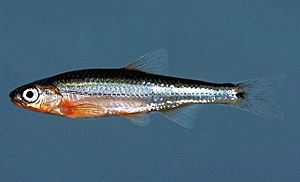Tennessee shiner facts for kids
Quick facts for kids Tennessee shiner |
|
|---|---|
 |
|
| Conservation status | |
| Scientific classification | |
| Synonyms | |
|
The Tennessee shiner (Notropis leuciodus) is a small fish. It belongs to the Cyprinidae family, which includes carps and minnows. This fish lives in the southeastern part of the United States.
Contents
What Does It Look Like?
The Tennessee shiner is a thin fish. It usually grows to be about 5 to 6.5 centimeters long. It has a dark stripe that runs along its side. A lighter stripe is also visible, going from its gills to its tail fin.
You can spot a rectangle-shaped mark near its tail. The scales on its back are dark. Its belly, however, is white. When male shiners are ready to breed, they change color. They turn a bright red-orange.
Where Does It Live?
This fish lives in many rivers across several states. You can find it in Alabama, Georgia, Kentucky, North Carolina, South Carolina, Tennessee, and Virginia. It is common in the Tennessee River system. It also lives in the Cumberland River and Green River areas.
The Tennessee shiner has also been found in the Savannah River and Kanawha River systems. It might have been moved to these places by people. Sometimes, fish used as bait are released into new waters.
Habitat
The Tennessee shiner is a freshwater fish. It lives in pools, small creeks, and medium-sized rivers. It likes cool, clear water. This fish prefers places with gravel at the bottom.
In these habitats, it often lives near other shiner species. These include the telescope shiner and the bigeye shiner.
Reproduction
Tennessee shiners usually breed in the late spring. During this time, male shiners gather in groups. They meet in shallow pools. Females visit these groups briefly to lay their eggs. After laying eggs, the females leave.
Sometimes, Tennessee shiners lay their eggs in the nests of other fish. They might use the nests of fish like the river chub or the largescale stoneroller.
Conservation Status
The Tennessee shiner is a widespread species. It has many populations living in different places. Most of these populations are stable. Some might be slowly decreasing in number.
There could be local threats to their habitats. However, the species as a whole is not facing major dangers. It is not a fish that scientists are highly worried about losing.
See also
 In Spanish: Notropis leuciodus para niños
In Spanish: Notropis leuciodus para niños


